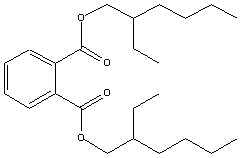DEHP
DI(2-ETILHEXIL) FTALATO

Alternativas
Mais informações
O tris (2 etil-hexil) trimelitato (TOTM), o di(2-etil-hexil) adipato (DEHA), o citrato de butiril trihexilo (BTHC) e o citrato acetiltributilo (ATBC), são as principais alternativas ao DEHP atualmente utilizadas em dispositivos médicos contendo PVC. O apelo a essas alternativas é duplo: em primeiro lugar, a maioria destes produtos químicos aparecem por serem menos tóxicos em comparação com o DEHP; em segundo lugar, podem ser comercializadas como ''livres de ftalatos" o que apela à confiança dos consumidores [26].






Referências Bibliográficas
[1] IARC Monographs 101 (2012): http://monographs.iarc.fr/ENG/Monographs/vol101/mono101-006.pdf (27/05/2014)
[2] REACH UE, Artigo 57 (c): http://www.reachonline.eu/REACH/EN/REACH_EN/article57.html (28/05/2014)
[3] ATSDR (2002), Toxicological Profile for Di(2-Ethyhexyl)phthalate: http://www.atsdr.cdc.gov/toxprofiles/tp9.pdf (27/05/2014)
[4] IARC Monographs (2000): http://monographs.iarc.fr/ENG/Monographs/vol77/mono77.pdf (28/05/2014)
[5] Towae, F., et al. (1992) Phthalic acid and derivatives. In: Elvers, B., Hawkins, S., Schulz, G., Ullmann’s Encyclopedia of Industrial Chemistry, 5th rev. Ed., New York, VCH Publishers, A20:181–211
[6] SCENIHR (2008): http://ec.europa.eu/health/ph_risk/committees/04_scenihr/docs/scenihr_o_014.pdf (28/05/2014)
[7] ECHA (2009), Background document for bis(2-ethylhexyl) phthalate (DEHP): http://echa.europa.eu/documents/10162/a2559f79-51cb-4004-bde1-0bf93bb5f2aa (28/05/2014)
[8] COWI, IOM & Entec (2009), Data on manufacture, import, export, uses and releases of Bis(2-ethylhexyl) phthalate (DEHP) as well as information on potential alternatives to its use. Report prepared for ECHA: http://echa.europa.eu/documents/10162/13640/tech_rep_dehp_en.pdf (28/05/2014)
[9] Restrições ao Uso de DEHP: http://www.dehp-facts.com/restrictions (28/05/2014)
[10] Normas da REACH: http://www.reachhelpdesk.pt (27/05/2014)
[11] Legislação relativa ao DEHP: http://www.dehp-facts.com/default.aspx?page=328 (28/05/2014)
[12] Toxics Use Reduction Institute (2005): http://www.google.pt/url?sa=t&rct=j&q=&esrc=s&source=web&cd=1&ved=0CC4QFjAA&url=http%3A%2F%2Fwww.healthandenvironment.org%2F%3Fmodule%3Duploads%26func%3Ddownload%26fileId%3D19&ei=HGWGU5frL4yO7Qag2oFA&usg=AFQjCNEHH1uqle8Sm4Oks29F9SPX8TAKBQ&bvm=bv.67720277,d.ZGU (28/05/2014)
[13] Halden, R. (2010), Plastics and Health Risks. Annual Review of Public Health 31:179–94
[14] ECPI (2007): http://www.ecpi.org/upload/documents/webpage/inform-issue14.pdf (27/05/2014)
[15] ECHA (2012): http://echa.europa.eu/documents/10162/13640/draft_axiv_entries_gen_approach_4th_en.pdf (27/05/2014)
[16] Koch, H. M., et al. (2005), Di(2-ethyhexyl)phtalate (DEHP): human metabolism and internal exposure - an update ant latest results. Institute and Outpatient Clinic of Occupational, Social and Environmental Medicine, University of Erlangen-Nuremberg, Erlangen, Germany.
[18] Becker, K., Seiwert, M. , Angerer, J. , Heger, W. , Koch, H.M. , Nagorka, R. , Rosskamp, E. , Schlüter, C. , Seifert, B. and Ullrich, D. (2004), DEHP metabolites in urine of children and DEHP in house dust. Int. J. Hyg. Environ. Health 207(5):409-417.
[19] Rusyn, I., et al. (2006). Modes of action and species-specific effects of di-(2-ethylhexyl)phthalate in the liver. Crit Rev Toxicol 36(5): 459-479.
Referências:
[21] Xu, Y., et al. (2010). Predicting Residential Exposure to Phthalate Plasticizer Emitted from Vinyl Flooring: Sensitivity, Uncertainty, and Implications for Biomonitoring. Environmental Health Perspectives 118.
[22] KADIISKA, M. B.; MORROW, J. D.; AWAD, J. A.; ROBERTS, L. J. 2ND; MASON, R. P. Identification of free radical formation and F2-isoprostanes in vivo by acute Cr(VI) poisoning. Chemical Research in Toxicology, v. 11, p. 1516-1520, 1998.
[23] RUSYN, I.; KADIISKA, M. B.; DIKALOVA, A.; KONO, H.; YIN, M.; TSUCHIYA, K.; MASON, R. P.; PETERS, J. M.; GONZALEZ, F. J.; SEGAL, B. H.; HOLLAND, S. M.; THURMAN, R. G. Phthalates rapidly increase production of reactive oxygen species in vivo: role of Kupffer cells. Molecular Pharmacology, v. 59. p. 744-750, 2001.
[24] Rusyn, I., et al. (2006). Modes of action and species-specific effects of di-(2-ethylhexyl)phthalate in the liver. Crit Rev Toxicol 36(5): 459-479.
[25] ATSDR (2002), Toxicological Profile for Di(2-Ethyhexyl)phthalate: http://www.atsdr.cdc.gov/toxprofiles/tp9.pdf (27/05/2014)
[26] Wang, Y. C., et al. (2012). Possible mechanism of phthalates-induced tumorigenesis. Kaohsiung J Med Sci 28(7 Suppl): S22-27.
[27] Rusyn, I. and J. C. Corton (2012). Mechanistic considerations for human relevance of cancer hazard of di(2-ethylhexyl) phthalate. Mutat Res 750(2): 141-158.
[28] Posnack, N. (2014), The Adverse Cardiac Effects of Di(2-ethylhexyl)phthalate and Bisphenol A. Cardiovascular Toxicology.
[29] Cheng S. et al. (2013), Cytotoxic effects of mono-(2-ethylhexyl) phthalate on human embryonic stem cells. Chinese Medical Journal 126 (9): 1714-1719
[30] http://www.ehow.com.br/ficar-longe-ftalatos-brinquedos-como_163384/ (28/05/2014)
[31] http://www.ehow.com.br/evitar-ftalatos-durante-gravidez-como_265223/ (28/05/2014)
[32] http://www.epochtimes.com.br/20-maneiras-evitar-plastico-comida-sangue/#.U4YVdPldWvM (28/05/2014)